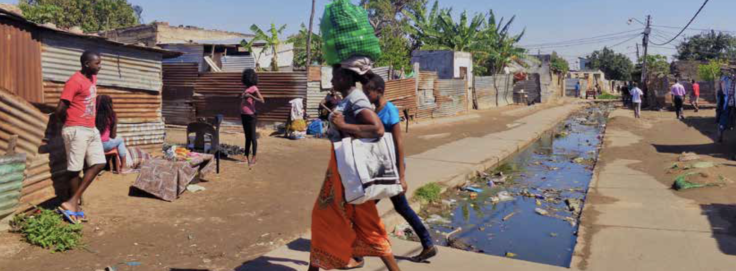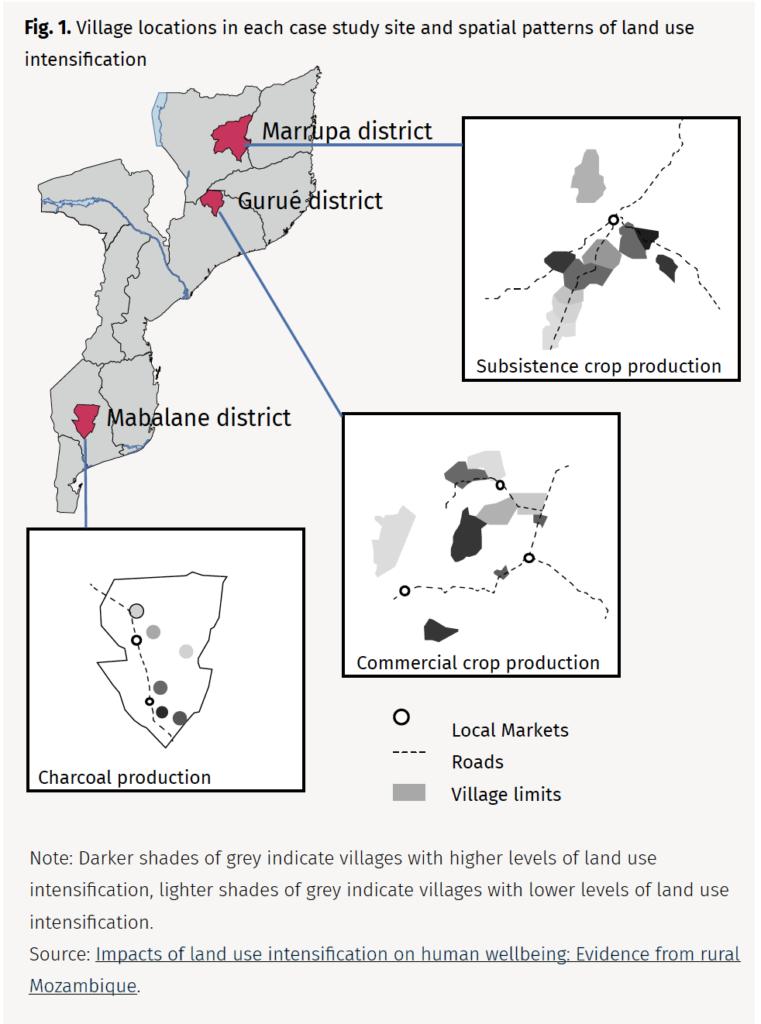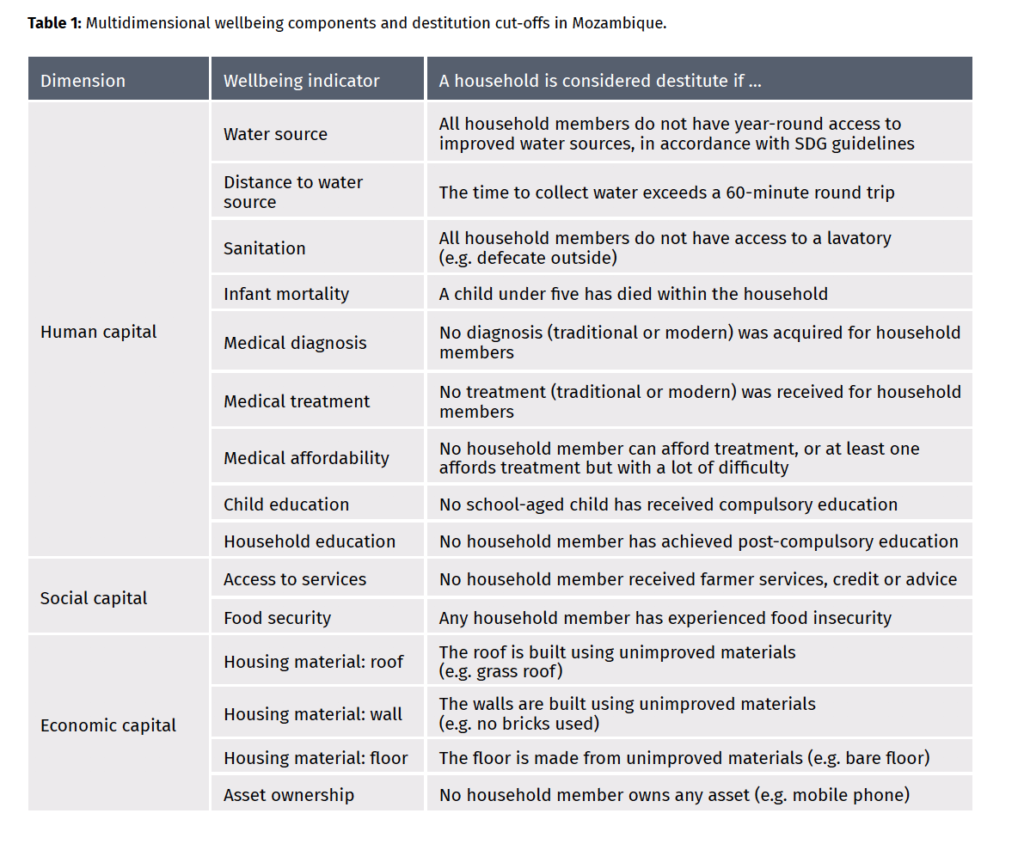
Search
Land use intensification and multidimensional destitution

What is the relationship between land use and the alleviation of multidimensional destitution in Mozambique? What lessons can be drawn for a broader context, beyond that of Mozambique, of regional trends towards land scarcity in Sub-Saharan Africa and beyond? What do these relationships mean for policy makers?*
Development economists emphasise the value of access to productive assets, such as land and forest resources, through which people can create routes out of poverty. When households have access to such resources, land use intensification (LUI) – enhancing the productivity, or profitability of a given area of land – has the potential to improve rural livelihoods.
Land use is set to intensify in Sub-Saharan Africa (SSA) alongside increasing rural population pressures and competition from national and global investors; much of the remaining available land is concentrated within a few countries. It is widely held that reducing poverty in SSA will rely largely on stimulating agricultural growth; cropland expansion is expected to be necessary for smallholder-led development across the region. Simultaneously, biomass energy (particularly of charcoal and firewood) is the most important fuel source for SSA and it plays a critical role in economic growth across the region.
But what are the environmental and social tradeoffs of LUI? Many rural households are inextricably dependant on woodland and forest-derived ecosystem services, such as productive soils, food and timber. The conversion of land for agriculture is the leading cause of deforestation in SSA. In parallel, biomass energy is a major contributor to forest and woodland degradation.
Whilst improvements in rural livelihoods are often an implicit assumption with LUI, and despite some evidence for beneficial wellbeing outcomes, there are concerns that associated negative environmental impacts may undermine rural livelihoods.
Many rural areas in SSA have high levels of multidimensional poverty, as identified in the global Multidimensional Poverty Index (MPI) for 2018 and 2019. Understanding how human wellbeing changes with LUI is therefore key in the pursuit of global development, especially as ecosystem services underpin many of the Sustainable Development Goals (SDGs). Furthermore, with the imperative of the SDGs to ‘leave no one behind’ and to end poverty in all its forms and dimensions, a disaggregated analysis of LUI and multidimensional poverty is critical to identify the most vulnerable and destitute groups, to recognise how they use, access and depend upon resources.
Mozambique: A good case selection
Mozambique retains surplus land available for intensification. This provided a novel opportunity to examine how the wellbeing of the poorest of the poor, the ‘destitute’, changed with intensification of three prevalent LUI pathways occurring in SSA, under conditions of relative land abundance:
➡ charcoal production,
➡ transitions from smallholder subsistence to commercial crop production,
➡ smallholder subsistence expansion.
Between 2014 and 2015, quantitative and qualitative social and geospatial data were collected from 27 villages: seven in Mabalane, and ten each in Gurué and Marrupa Districts (Fig. 1).
Tracing land use intensification (LUI)
The impacts of LUI on rural livelihoods and multidimensional poverty are not well understood. Research tends to focus on environmental impacts of agricultural intensification and expansion. The few existing examinations of livelihood impacts mostly assess the extent of a particular land cover (e.g. swidden agriculture), or of unidimensional intensification indicators such as agricultural yields or fertiliser application rates.
Yet, LUI is a complex process that integrates multiple dimensions embedded within complex socio-ecological systems. Furthermore, land use impacts have scarcely been traced through to livelihood and wellbeing outcomes, or to an examination of the net multidimensional and social-ecological outcomes.
To fill this research gap, we applied two distinct and multidimensional measures. First, an integrative LUI conceptual framework was adopted, where LUI is a combined process of inputs to a production system (e.g. of land, labour or technology), outputs from the production system (e.g. products and services) and modifications to system properties and functions (e.g. to soil quality, biodiversity and carbon stocks and flows).
Secondly, multidimensional destitution needed to be measured, and the destitute (the poorest of the poor) identified.
Reaching the poorest of the poor thus requires economic benefits to be retained locally and productive investment opportunities to be made available.
Who are the ‘destitute’?
The destitute are the poorest of the poor; a subset of the multidimensional poor so deprived that they fall below the most extreme deprivation cut-offs. For example, not owning any assets characterises a household in destitution, whereas owning one small item such as radio constitutes a household as deprived in assets. This technique to identify the poorest of the poor is called the depth approach. In Mozambique, given the high severity of multidimensional poverty in Gaza, Zambézia and Niassa provinces, the focus on destitution was chosen for these three study districts.
The indicators and dimensions (see Table 1) were selected by triangulating participatory wealth rankings results, focus group discussions and a structured secondary literature review (for the full methodology of the identification process see here). The index is comprised of 15 indicators, grouped across three dimensions. A household is classified as multidimensionally destitute if they are considered destitute in at least four indicators, across at least two dimensions.
Destitution headcounts reduce under favourable circumstances
We analysed how LUI had differential impacts on livelihoods, multidimensional wellbeing and destitution, and showed that market access had a role to play.
Results found increases in multidimensional wellbeing with expansion of commercial and subsistence agriculture. However, reductions in the percentage of people considered destitute were only observed with transition and expansion of commercial crop production into forested land (in Gurué District, see Fig. 2).
In this case, people had higher market access through better-developed market infrastructure and low-cost barriers (e.g. nearby markets and internal market access within villages). Results from this site also showed reductions in the proportion of households considered destitute in the following five indicators: household education, child education, roof material, water source and access to farming services.
In contrast, destitution did not change in sites with lower market access, neither with the intensification of charcoal production (in Mabalane), nor with the expansion of subsistence cultivation (in Marrupa). This suggests that under these circumstances, benefits from LUI struggled to reach the poorest of the poor.
The empirical evidence supports claims that access to sustainable and inclusive markets is essential for pro-poor growth strategies. Charcoal markets in Mozambique and across SSA are ill-defined, poorly supported and rarely functioning. Without a functioning market for charcoal, resources are harvested unsustainably, resource degradation ensues and rural production markets shift to increasing distances from urban demand centres leaving a trail of forest degradation in their wake.
In contrast, commercial agricultural markets across SSA are better supported, as their development is considered critical for economic growth across the region. Unlike commercial agriculture however, by definition, subsistence agricultural production has limited market dependence, as per-capita production (and consumption) remains constant, irrespective of functioning markets.
Reaching the poorest of the poor thus requires economic benefits to be retained locally and productive investment opportunities to be made available. Sustainable and inclusive markets are therefore essential developments alongside LUI to improve wellbeing, particularly for the poorest households, to ensure that no one is left behind.
* This is a short version of the paper published in Global Environmental Change.
Photo: Unplash/Farah Nabil
This article was published in Dimensions 11



















